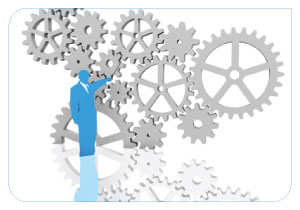
What is Process Automation? Where Does Document Generation Fit In?
Based on the lifecycle of user interaction, there are two types of software: perpetual use software and process software. Perpetual use software may be used to generate evolving work product over an extended period of time. A good example of perpetual use software is Microsoft Word. A user could create a file today and then modify the same file on an ongoing basis in perpetuity.
Process Applications
In contrast, process applications are characterized by a trigger, a progression of steps or stages, and a clearly defined end. Because real-world business process is ever evolving, process automation technology (the software used to transform real-world processes into automated workflows) tends to be of the RAD variety (Rapid Application Development), and is commonly distributed by BPM (Business Process Management) vendors, case management vendors (including advanced Case Management and Adaptive Case Management.), and ECM vendors, which are looking to grow into vertical solutions, many of which involve process applications.
Types of Process Applications
Within the world of process automation, there are three types: (1) structured process, (2) ad-hoc process, and (3) unstructured process.
Structured Process
Structured process involves a highly predictable series of stages with business logic controlling the flow of the process through an organization. Consider, for example, a loan-origination process in a bank or a policy-origination process in an insurance company.
Ad-Hoc Process
Ad-hoc process is relevant in situations where the stages in a process are less predictable. Consider, for example, a law firm that engages in several different practice areas, many of which overlap. As a case or transaction arises, a knowledge worker in the firm may need to construct the process (workflow) on the fly, based on the unique characteristics of the case.
Unstructured Process
Unstructured processes are frequently the domain of case management systems, and result when a situation becomes so complex that a knowledge worker must be introduced to sort through its vagaries. Unstructured process occurs commonly in government agencies, such as those dispersing government services on a case-by-case basis.
Document Generation Process
Within the greater technology class of process automation is document generation software, which focuses on the highly predictable, structured process of generating complex, transactional legal documentation. Document generation software enables knowledge workers—rather that software engineers— within an organization to transform legal documents into process applications. A document generation process app queries the process user for all the data necessary to generate a document (or set of documents) and, based on the data, merges simple and computed variables and includes/excludes language based on conditional and repeating logic.
Enterprise-grade document generation (document assembly) platforms, such as the industry-leading HotDocs, not only enable the transformation of documents of any length and complexity into process apps, but also provide deployment platforms for any environment, including desktop, client/server, and cloud. Furthermore, such platforms will have highly evolved APIs, enabling integration of document generation apps into broader workflows and case management environments.